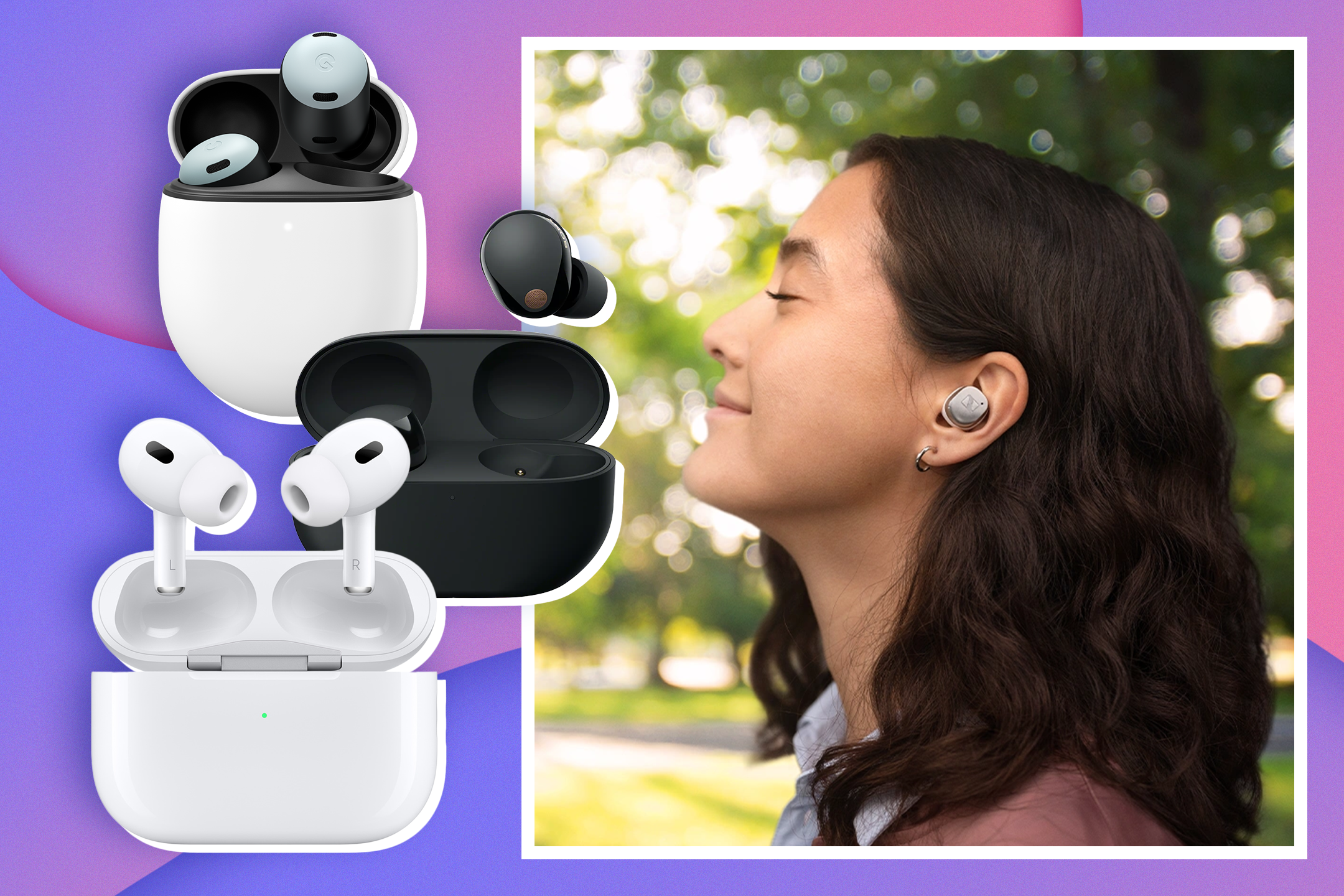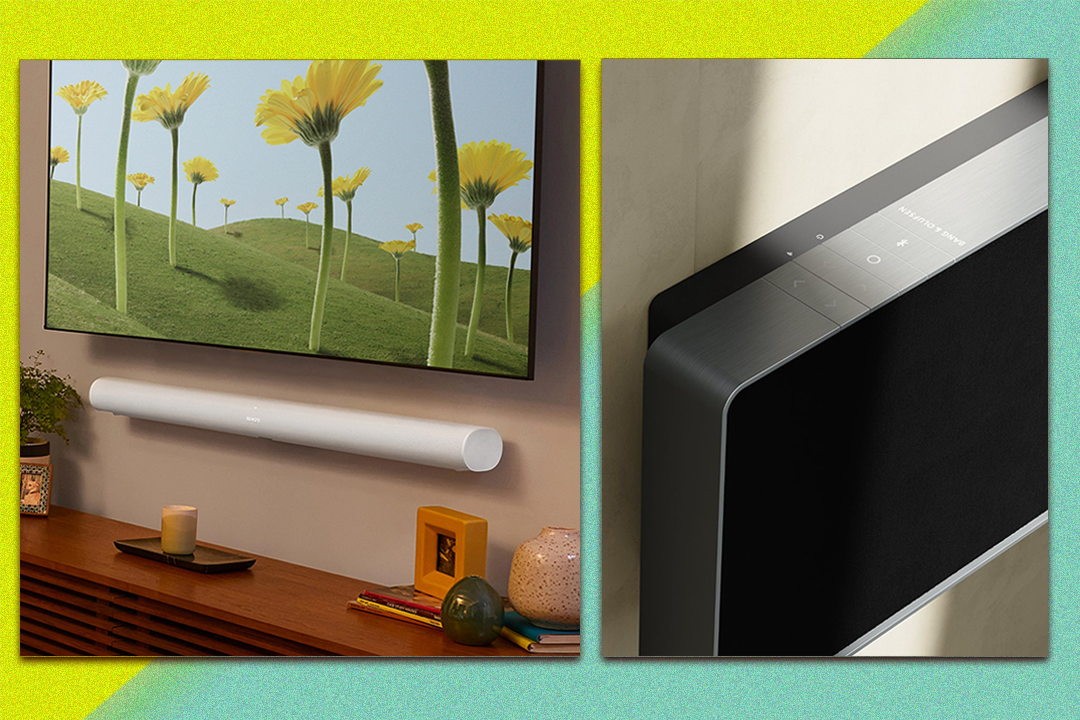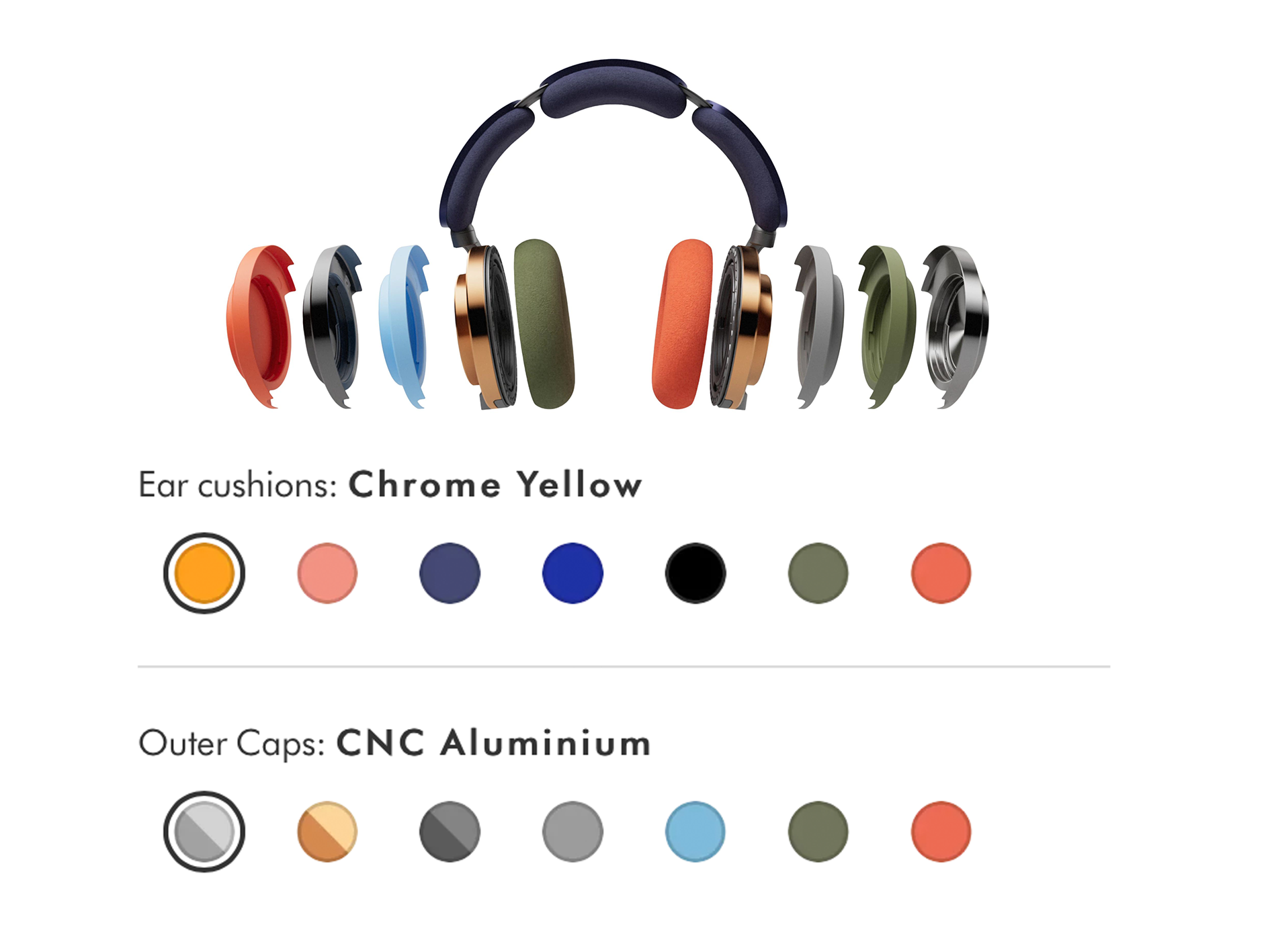Dyson ontrac wireless headphones

- Type: Over-ear
- Noise-cancellation: Yes
- Weight: 451g
- Battery life: 55 hours with ANC on
- Connection type: Bluetooth 5.0 without multipoint, NFC, USB-C port
- Bluetooth codecs: SBC, AAC and LDAC
- Voice control: Yes, integrated Alexa and Google Assistant
- Why we love it
- Class-leading active noise cancellation
- Fantastic modular design for ultimate personalisation
- Excellent audio quality
- Take note
- Missing multipoint connectivity
- No spatial audio
These might be the best-looking headphones I’ve ever laid my eyes on – and I’ve tested a lot of headphones. Think the allure of a pair of Beats but for a 2024 audience. They look a lot like the Dyson zone, but they are more refined. Though fairly chunky, the ear caps are much slimmer than those of the zone, so, they don’t jut out from your head like you’re a walking Cyberman.
It’s the colours, however, that make them really pop, offering a unique proposition for wireless headphones. You can buy them in a choice of four different colour combinations, with a different headband colour, a different ear cushion colour and a different ear cap colour (in two materials).
Default colour combinations include a Prussian blue headband with a CNC copper ear cap and Prussian blue ear cushions; a CNC aluminium headband with yellow ear cushions and aluminium ear caps; a ceramic cinnabar headband with dark iron cushions and ceramic cinnabar caps; and a CNC black nickel colourway with dark iron cushions and nickel ear caps.
But here’s where it gets exciting. You don’t have to stick with the base ear cap colours and ear cushions. There are more than 2,000 different potential colour combinations to choose from, if you want to get creative and really personalise your gear. The super wacky amongst us could even use four different cap and cushion colours in one bold Frankenstein creation.
Read more: We review the best wireless earbuds
There are seven different ear cap colours, including blue, khaki and titanium, as well as seven different ear cushion colours, including ultra blue, oyster pink, Prussian blue and more. Dyson has a digital lab where you can visualise all the different colour combinations in 360 degrees, giving you a completely customised look.
These extra caps and cushions are all sold separately, however, so you’ll end up paying more per ear cap and cushion set. New pairs of ear cushions and ear caps cost £49.99 per set.
Easy to swap out, you just twist either ear cap or ear cushion in a counter-clockwise direction until it clicks and then it’ll pop off. You can then replace the ear cap or ear cushion with the colour of choice, by clicking it in and rotating it clockwise. It’s really simple to do, with a bit of practice.
I’ve been testing the CNC copper colour combination with the Prussian blue headband and black ear cushions but, whichever colour combination you go for, the Dyson ontrac is a striking pair of headphones that look absolutely fantastic.
Read more: Top-rated waterproof headphones
The micro-suede ear cushions are incredibly comfortable, with no harsh clamping force, and the multi-pivot gimbal arms help to relieve any excess ear pressure. Fully adjustable, the arms pull out in steps, so you can judge how far they extend. They aren’t the most secure, however, so they won’t be good for running – any severe movement of my head, and the cans were close to falling off.
What I really liked about the design was that Dyson decided to put two high-capacity batteries in the headband, so it feels as though the weight is more evenly distributed on the side of my head, rather than on my ears. Because of the positioning of the batteries in the lower part of the headband, Dyson has been able to give the headphones a decent amount of juice. You get a huge 55 hours per charge (or two weeks’ worth of listening), even with ANC turned on.
The ontrac never felt uncomfortable or too heavy, even after a few hours of wear, and the soft cushioning on the middle part of the headband helped it sit gently on my skull.
While they don’t fold up or away, that means the chances of the headphones snagging in your hair are reduced. The slide-in carry case is another nice design choice – headphones with hard shell cases take me an age to figure out how to use, as you have to fold the ear cups a certain way to get them to fit inside. In contrast, the Dyson headphones slip into the accompanying case, fitting snugly inside.
Controls
The controls on the Dyson ontrac are almost exactly like the Dyson zone’s. You can double tap (rather firmly) on either ear cup to switch between active noise cancellation and transparency modes (more on that below). Meanwhile, there’s a circular joystick on the right ear cup, which controls audio – toggling it up or down increases or decreases the volume; a single press pauses and resumes playback; shifting it left and right skips tracks, and holding it down activates the voice assistant. It’s so simple to use.
Read more: The best sleep headphones
The cans also turn off after 30 minutes of use. They feature on-ear detection, so your music will pause when you take the headphones off your ears and resume when you put them back on.
Active noise cancellation
These might be some of the best noise-cancelling headphones I’ve ever tested – as good (and maybe even better) as the Bose quietcomfort ultra. I could barely hear a thing with active noise-cancellation turned on. It felt like I was in a black hole, void of sound. The only thing that slipped through was the sound of racing cars outside and my family screaming for Team GB athletes while watching the Olympics downstairs.
How is it so good? Dyson says the ontrac features a custom ANC algorithm that uses eight microphones inside the headphones, to sample external sound 384,000 times a second, cancelling up to 40dB of unwanted noise. It’s pretty remarkable.
Transparency mode was also good, but not quite as good as the AirPods max. While a great amount of sound was let in, it did muffle some external noise. This didn’t get on my nerves too much, though – it’s still good, just not the very best. I did notice, however, that there was no noticeable hiss with transparency mode turned on, something I loathe when it comes to some wireless headphones.
Read more: Find the latest deals on Apple Airpods
The ANC isn’t adaptive, however, so it won’t change according to your environment. You’ll just have complete silence when you listen to your headphones with ANC turned on.
Sound
While these don’t have lossless audio, they still sound really good. They feature 40mm, 16-Ohm neodymium speaker drivers, reproducing frequencies from 6Hz to as high as 21,000Hz. That means you get deep sub-bass and clear highs.
The deep sub-bass really came across when listening to tracks such as Skrillex’s “Push”. It felt like I was at a gig, the speakers pounding against my ears with complete clarity. The bass boost setting made the effect even heavier.
High-frequency sounds and vocals on tracks such as “I am Woman” by Emmy Meli came across as crystal clear. Honestly, they sound fantastic, with no distortion, delivering buttery smooth audio. One of the best-sounding headphones I’ve tested, and that was just on regular AAC.
They were almost completely lag-free when testing with my iPhone 15 pro max – something I’ve rarely seen on headphones that aren’t Apple-made. In terms of connections, you can pair them via AAC, SBC and LDAC, which gives you lossy-like audio, but no lossless via AptX or AptX Adaptive. You can also plug it in via USB-C, for wired listening.
Features
While these headphones are undoubtedly very good-looking and have impressive ANC and sound quality, they’re lacking a bit in the features department.
Read more: Dyson’s supersonic nural hair dryer, reviewed
There are some strange omissions: Dyson didn’t include any form of spatial audio on these cans – just bog-standard sound, and there’s no multipoint connectivity, which would let you connect it to more than one device simultaneously. You don’t get cool features such as conversation boost (which lowers the volume and turns on transparency mode when you start talking), either.
These are features regularly available on mid-range headphones, let alone higher-end headphones, which the Dyson ontrac are purported to be, with a price tag of £449.99 (the same price as the AirPods max and Bose quietcomfort ultra).
So, what do you get? Inside the app, you get detailed information about your headphones. What’s really neat is it includes an always-listening sound exposure monitor, telling you (in decibels) the level of in-ear sound and the level of external sound in the past 30 seconds. This is a really nifty little feature, and very, very Dyson. It told me if the external and in-ear sound of the headphones was too loud or OK, so I knew when to turn down my music and when to turn on ANC.
You also get a three-step equaliser, letting you choose between an enhanced mode, a bass boost mode and a neutral mode. Enhanced focuses on higher frequencies for a crisp sound with prominent treble and vocals, while bass boost focuses on lower-end frequencies for a heavier sound with strong bass. Neutral gives you a flat, equal sound.
Battery life is very impressive, blasting the competition out of the water. As mentioned earlier, you get 55 hours of battery life, even with ANC turned on. That’s a lot, compared with the AirPods max, which only have 20 hours, and the Bose quietcomfort ultra, which get you 24 hours with ANC turned off and just 18 hours with it turned on.






